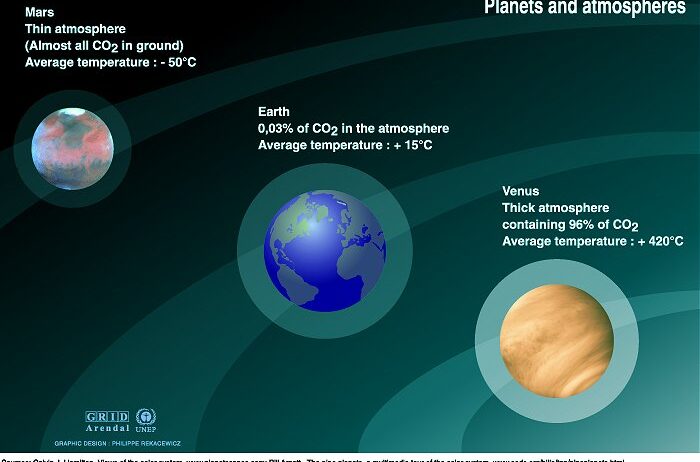The phenomenon of global warming is not isolated to Earth alone. While our planet bears the brunt of anthropogenic climate change, celestial bodies within our solar system exhibit changes in their atmospheric conditions that prompt investigations into their climatic trends. This prompts the question: are all planets experiencing global warming, or is it just Earth?
The concept of global warming generally refers to the incremental rise in Earth’s average surface temperature due to increased greenhouse gas emissions, particularly carbon dioxide (CO2). However, the same principles of atmospheric science can not only be applied to our home planet but also to other planets, each possessing unique environmental and climatic characteristics. To fully comprehend this, it is imperative to explore various planetary bodies to discern whether they are experiencing shifts in their climates reminiscent of Earth’s global warming.
Venus: A Case Study of Catastrophic Greenhouse Effect
Venus stands out as a striking case of a runaway greenhouse effect. With surface temperatures soaring beyond 900°F (475°C), it is often referred to as Earth’s “evil twin.” Its atmosphere, primarily composed of carbon dioxide, exhibits an atmospheric pressure 92 times greater than that of Earth. This dense blanket of greenhouse gases captures and retains heat, resulting in a blistering climate. While current conditions on Venus reflect a scorching and inhospitable environment, hints of historical climatic changes suggest that it may have had conditions resembling Earth’s early atmosphere, potentially capable of supporting liquid water. Thus, Venus is experiencing a form of global warming, though drastically different from Earth, propelled by its inexorable greenhouse effect.
Mars: Climate Change and Atmosphere Loss
In stark contrast, Mars presents a narrative of cooling rather than warming. Once believed to have had a dense atmosphere conducive to liquid water, the Red Planet now hosts a thin atmosphere consisting largely of carbon dioxide. Over geological timescales, Mars has undergone significant climatic transformations, leading to its current frigid temperatures averaging −80°F (−62°C). The loss of its atmosphere, exacerbated by solar wind stripping and the absence of a substantial magnetic field, has rendered Mars inhospitable. Although Mars is not experiencing global warming in the traditional sense, it is illustrative of how climatic conditions can evolve drastically, leading to a planet’s decline into a frozen wasteland.
Jupiter and the Gas Giants: Turbulent Atmospheres
Jupiter, as the largest planet in our solar system, presents an intriguing study due to its colossal gaseous atmosphere, which showcases intricate weather patterns and violent storms. The Great Red Spot, a gigantic storm that has raged for centuries, serves as a testament to Jupiter’s dynamic climate. While studies have not definitively linked Jupiter’s atmospheric phenomena to global warming as understood on Earth, changes in atmospheric composition, temperature fluctuations, and storm intensity hint at underlying, evolving climatic processes. Though gas giants are not experiencing global warming in the conventional sense, they exhibit their own volatile atmospheric behaviors that merit closer examination.
Saturn: Seasonal Changes and Atmospheric Phenomena
Saturn, renowned for its stunning rings, also houses an atmospheric realm worth scrutinizing. With beautiful bands of clouds and intense storms, Saturn experiences seasonal changes similar to Earth. Research indicates variations in the planet’s temperature and atmospheric dynamics, particularly in the polar regions. Although these phenomena likely result from its axial tilt and distant solar radiation, the atmospheric alterations raise intriguing questions about long-term climatic trends. It is crucial to differentiate between seasonal changes and a global warming narrative; however, Saturn’s complex atmospheric patterns undoubtedly contribute to our broader understanding of planetary climates.
Exoplanets and the Broader Cosmic Perspective
The exploration of extraterrestrial worlds—particularly exoplanets—opens avenues to discourse about climate and warming phenomena beyond our solar system. Some exoplanets orbiting within the habitable zone of their parent stars may exhibit conditions conducive to liquid water, thus prompting speculation about potential global warming analogs. For example, researchers have detected substantial atmospheric temperatures on planets like WASP-121b, where extreme heat raises questions about potential greenhouse effects on a planetary scale. While such discoveries may only be in nascent stages, they underscore our expanding comprehension of climate dynamics across the cosmos.
Conclusion: The Interconnectedness of Planetary Climates
Global warming is often perceived through a terrestrial lens, focusing predominantly on its impacts on the climate, biodiversity, and human societies of Earth. However, understanding climate change necessitates a comprehensive approach that encompasses various planetary bodies. From the hellish surface of Venus and the frigid expanses of Mars to the turbulent atmospheres of gas giants, each planet illustrates fragments of a broader cosmic narrative regarding climate change. While Earth may be the focal point of global warming discussions, observing the climatic behaviors of other planets enriches our knowledge and highlights the complex interconnectivity of planetary systems. The exploration of these distant worlds further accentuates the urgency of addressing the pressing issue of climate change on our own beloved planet.








